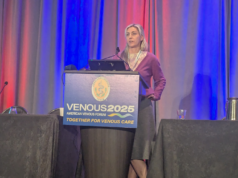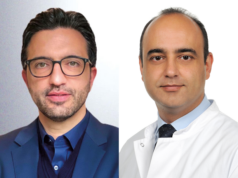
Efficacy data from the Arnsberg Registry at 12 months are promising, with high primary patency rates for a dedicated venous stent.
Presenting the data at the Leipzig Interventional Course (LINC; 30 January–2 February, Leipzig, Germany), the registry’s principal investigator Michael Lichtenberg (Klinikum Arnsberg, Arnsberg, Germany) pointed to the need for dedicated venous stents for venous anatomy and disease.
On this occasion, Lichtenberg presented data from the Arnsberg Venous Registry relating to the Venovo venous stent (Bard/BD).
The Venovo venous stent is a self-expanding nitinol stent with a dedicated design for venous vessels. The stent has six markers at each end, and the ends are flared to 3mm to ensure wall apposition. It is intended for the treatment of patients with chronic venous outflow obstruction.
Lichtenberg noted that in his opinion, a particular advantage of the stent system is the tri-axial delivery system, with a dual-speed deployment thumbwheel and ergonomic handle. “With the delivery system you are really able to precisely implant the stent without any problems of foreshortening or forejumping of the stent,” he said.
Giving some background to the development of the stent, Lichtenberg spoke about the key features needed for venous stents, including radial resistive force and chronic outward force.
“In venous intervention it is very important to have a very good radial resistive force and chronic outward force, especially in patients with obstruction in the May Thurner point where you need high radial resistive force to cover the May Thurner syndrome. On the other side, you also need to have flexibility, so it is also a compromise of outward force and flexibility that venous stents need to have,” he indicated.
The Arnsberg Venous Registry was started in 2013 at Klinikum Arnsberg, in which patients with iliofemoral obstructions, acute deep vein thrombosis, chronic deep vein thrombosis or May Thurner syndrome are included. For each of the existing venous stents there is a sub-cohort analysis.
For the Venovo venous stent cohort analysis Lichtenberg and colleagues assessed the safety and effectiveness in achieving patency of target venous lesions through 36 months post stent placement in patients with non-thrombotic iliac vein lesions and post-thrombotic iliac vein lesions. The effectiveness outcome is primary patency and clinical outcome at 12 months.
Of the 80 patients included, 50 patients (63%) had post-thrombotic syndrome and 30 (37%) had non-thrombotic syndrome. Further, 48% of the patients had a Comprehensive Classification System for Chronic Venous Disorders (CEAP) C4 score and most of the patients complained of pain and persistent swelling.
The patency analysis was done by duplex ultrasound. Lichtenberg reported that at 12 months the primary patency was 96% and the secondary patency was 97%. Subdividing the patient groups into those with non-thrombotic iliac vein lesions (NIVL) and those with post-thrombotic syndrome, he added that primary patency and secondary patency remains high (NIVL group 96.6% primary patency and 100% secondary patency; post-thrombotic group 95.7% primary patency and 95% secondary patency).
In terms of clinical outcomes, 51% of patients had substantial clinical improvement (rVCSS ³2) at 12 months, especially relating to venous claudication and persistent swelling. Further, eight out of 10 venous ulcerations were healed at 12 months, and the CEAP score decreased from 4.26 at baseline to 2.83 at 12 months.
As it relates to safety outcomes, Lichtenberg said that at 12 months there were only four access site complications and three early stent reocclusions, but no stent migration, no clinically significant pulmonary embolism and no venous rupture.
“Our six and 12 month data are very promising. Safety data raised no concerns, and from my perspective, the most important this is that patients feel substantially better—the VCSS score dropped significantly, and there was improvement especially in venous claudication and ulceration,” Lichtenberg concluded.
“Let me stress my opinion that venous anatomy and disease requires dedicated venous stents. Venous obstruction in the iliac system are not for arterial stents. We have very good venous stents now available, please only use venous stents for recanalisation,” he further pointed out.









